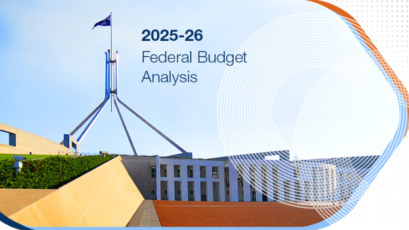Market commentary
Below is a summary and highlights from the movements this quarter and major changes to some of the key asset areas:
Australian equities
The Australian equity market (as measured by the S&P/ASX 200 TR) bounced back from a sluggish start to the quarter, to return (+2.75%) for the month of December and end the year on a positive note. The December quarter returned (+2.09%) to round out what was a tumultuous 2021 for equity markets. The calendar year returned a pleasing (+17.23%). Despite the growing fears of ongoing coronavirus and inflation concerns, the Australian market showed great resilience post the hard slog of 2020 as the market continued to focus on company fundamentals and assisted greatly by easing lockdowns in most states.
The strongest sector returns for the quarter were Materials (+12.7%), assisted by strong performance within metals & mining sub-sectors, Utilities (+11.4%) and Real Estate (+9.3%). Laggards included the Energy sector (-8.8%), which gave back the previous quarter gains, Information Technology (-6.1%) and Financials (-2.2%). Performance across the smaller-mid size market cap spectrum (company size) broadly followed the same path across the quarter, Mid-caps (+3.9%) and Small-companies (+2.0%). And despite lagging Growth by 4% in the final quarter, Value completed its first year of outperformance in five and only its second year of outperformance in the past decade. The S&P/ASX Value Index (+20.9%) versus the S&P/ASX Growth Index (+13.3%)
International equities
Off the back of strong US earnings and signs of economic stabilisation in China, Global equity markets rallied in October and continued to post solid monthly gains despite increasing concerns over rising inflation, more hawkish central banks views and statements (commencement of asset tapering in 2022), and concerns over the new Omicron variant. However, although equity volatility saw a dramatic spike in November as a result of the new variant, markets quickly recovered and by the year-end these concerns had largely subsided, whilst US data continued to indicate its economy overall remained stable and corporate earnings were robust; S&P500 (+36.0%) and NASDAQ (+29.7%) providing confirmation of a strong US led recovery. The broader global equity market (MSCI World NR AUD) returned (+7.1%) for the quarter, ending a strong calendar year (+29.3%). The index has now returned ten-years of positive-growth having last seen a negative year in 2011. The index has outperformed the S&P/ASX 200 TR index by an average of (+6.2%) – unhedged – over this period.
Unhedged indices outperformed their hedged equivalents as the Australian Dollar depreciated relative to the US Dollar over the quarter and year driven mainly to a sharp fall in the iron-ore price.
Emerging Markets (MSCI EM Index AUD) unfortunately continue to lag (-1.9%) as Chinese equities significantly underperformed global equities contributing approximately 25% of the underperformance of emerging market equities versus developed markets. Coupled with extreme inflationary pressures in Turkey, political upheaval in Chile and geopolitical tensions between Russia and the West, EM (+3.4%) for 2021, continues to be under pressure. Pockets of EM do however continue to provide some relief. Geopolitical uncertainty and continuing concerns over potential monetary policy tightening continue to remain major potential headwinds as does the prospect of higher US rates. Europe (STOXX Europe 600 index) returned (+4.9%) for the quarter (+23.2%) for the year, with strong corporate earnings being the main catalyst; Asian markets (MSCI AC Asia Ex Japan) continues to struggle (-1.9%) for the quarter as broader markets sold off due to the emergence of Omicron and potential reinstatement of restrictions. The long-term growth and investment outlook for emerging markets however still looks compelling on a relative basis.
Property & Infrastructure
The Australian listed property sector (S&P/ASX 200 A-REIT) performed strongly, returning (+10.1%) for the quarter. The reopening trade now seems to be fully priced in although performance divergence across sub-sectors remains as repercussions of the pandemic and government responses are still being primarily felt in the hotel, office, and retail sectors. Performance across niche sectors such healthcare, childcare, self-storage, and logistics continue to perform strongly. The Domestic sector however continued to underperform its global counterpart, given the greater availability of these niche sectors offshore and a falling Australian dollar.
Global listed property also performed very strongly with (unhedged) returns (+11.7%) and hedged returns (+9.2%), with the former benefiting from a falling Australian dollar. M&A also continues to be rampant globally adding to further price appreciation and opportunity.
Global listed infrastructure (unhedged) returned (+7.1%) for the quarter versus currency hedged returns (+7.5%). The sector bounced back aggressively form the disasters of 2021 to record their highest yearly returns for over a decade. No doubt assisted by the bipartisan US infrastructure bill, the realisation globally that significant infrastructure spend is coming, and with cashed up pension and private equity vehicles chasing a dearth of available infrastructure assets available for sale.
Bonds and Cash
Central banks globally, including the RBA continue to remain accommodative in support of markets although fears of an overshoot in inflation gathered further momentum as rhetoric turned hawkish. Talk of an accelerated tapering process and fear of the Omicron variant did result in at times extreme volatility (U.S. yields traded between 1.7% and 1.4%), however yields on 10-year treasuries, both domestically and globally did not appreciate to the extent as most thought from the close of the previous quarter. The 10-year Australian Treasury yield increased from 1.488% to 1.631% whilst the 10-year US Treasury yield barely moved, increasing only 2 basis points from 1.487% to 1.512%. UK 10-year yield fell from 1.02% to 0.97% whilst German 10-year yields remain in negative territory, -0.17% to -0.19%. Shorter dated bond yields did however increase substantially on a relative basis indicating increased short to medium-term inflationary and pricing pressures. For the quarter, Australian bonds (Bloomberg AusBond Govn 0+Yr) returned (-1.44%) whilst global bonds (BBgBarc Global Aggregate TR Hedged) returned a flat (+0.03%). Investment grade corporate bonds lagged Government bonds for the quarter whilst higher yielding bonds continue to remain well supported (spread contraction resulting in rising prices) as the hunt for yield continues in earnest. Cash yields remained untouched as the RBA left the official rate at 0.10% throughout the quarter.
Quarter in review
The December quarter was definitely an interesting one with virus fears subsiding and then re-escalating again, Chinese economic growth showing some signs of improvement, and growing fears of the impacts of rising inflation globally, particularly on investment markets, as central banks considered their next steps.
Inflation appears to be a particular problem for the US, the UK, and some emerging market countries, whilst being less of a concern for Europe, Japan, China, and Australia to a lesser extent. For now, anyway. However, US inflationary concerns and the likely US central bank reaction function primarily drove markets in the quarter with expectations rising that the bank may have to end their money printing efforts early which would kick off the earlier than forecast rate rise cycle, with calls from market participants for 4-5 rates rises versus the previously expected 2-3 rate rises for 2022.
Whilst its clear investors were fixated on the evolving inflation narrative in the quarter there were also ongoing concerns regarding the health of China’s economy, rising oil prices, and rising geopolitical tensions including Russia / Ukraine (involving the US and Europe) and China / Taiwan.
Covid restrictions appeared to ease in the quarter both locally and globally, but fears rose again as the new variant appeared to be significantly more transmissible. This impacted supply chains and the availability of labour yet again, with consumption patterns also appeared to have changed at the back end of the quarter. Governments locally and globally appeared to be more calm and less inclined to rush towards increased restrictions which helped settle investor concerns. Time will tell if this remains the case.
Looking Forward
Overall, our outlook remains positive in that:
- there is plenty of stimulus still in the system
- there remains relatively high household savings, further supported by rising wealth, meaning pent-up consumption
- corporate balance sheets are in good shape
- broad re-opening should see a swift pick-up in the services part of the economy (and subsequently less goods demanded)
- rates of return on defensive assets are still too low, which could further support growth asset flows
However, risks remain, and these are fairly sizable risks with the potential to unravel in a fairly messy fashion, including covid policy responses, the inflationary threat, and the weakened Chinese economy, with a watchful over geopolitical risks and election cycles.
Asset price returns and volatility in 2022 will be largely dependent on how and when these risks are resolved. As such, we expect a bumpier ride for markets in 2022, with asset selection likely to be key. Corporates and households appear in good shape, but how long they remain in good shape will largely depend on how quickly governments and central banks exit their emergency policy paths.













